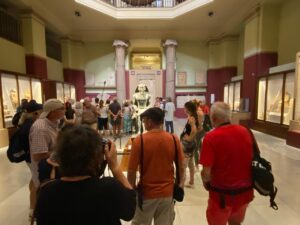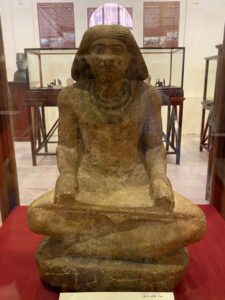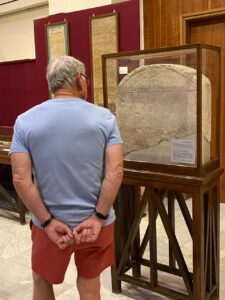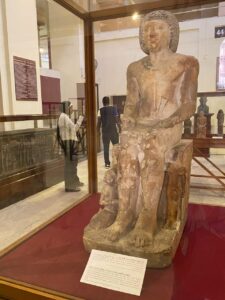A seated scribe holding a papyrus roll or sitting cross-legged and the papyrus roll placed on his lap is one of the most popular subjects in ancient Egyptian art, and even the highest officials chose to be depicted this way.
Scribes were highly valued and respected in ancient Egypt as a manifestation of the god of writing Thoth. But what did they write? What materials they used in writing and many questions that have answers at the Egyptian Museum in Tahrir.
Until the end of October, the Museum is holding an exhibition in the ground floor, Hall 44, to celebrate the 200 years of Egyptology.
At the exhibit, there are banners and artefacts related everything about scribes and their work. They were recording the tax collection process and calculating the harvest, accompanying the soldiers in military campaigns, and providing their services, especially in editing letters and wills and reading correspondence.
On display is a grey-granite statue of a scribe seated on a plinth wearing a long wig with little curls arranged in horizontal rows lapping over each other and a kilt. It dates back to the 5t Dynasty, Old Kingdom (c. 2686-2181 BC).
The ancient Egyptians invented various materials, tools and means for writing. They took advantage of all the bounties of nature to achieve this. They invented papyrus parchment, wax plates, and before that they used shreds made of pottery, limestone, bone and wood.
The artefacts also show that scribes used black ink which is made of ground charcoal mixed with water and sometimes burnt animal bones.
Red ink is made from oxidised iron, also known as haematite. They used red ochre for dates, titles and headings to distinguish them from the rest of the text or in corrections.
The Ancient Egyptians used other colours in painting statues or scenes on walls such as blue which is made from copper and iron oxides with silica and calcium and yellow which is made from ochre and oxides originally but, from the New Kingdom (c. 1550 BC-1069 BC) it was mixed from arsenic trisulphide.
Green is made from malachite, and white is made from chalk.
They used reeds to write texts, which permitted them to vary the thickness of the line. Reeds were held in a palette (usually wood) which had a depression to hold especially the red and black inks.
Scribal tools and materials used by the ancient Egyptians for writing include palettes, colours, stone for grinding the colours, brushes for painting, reed pens, columns to preserve the reed pens are on display.
Don’t miss to see this wooden inscribed model papyrus roll dates back to the New Kingdom.
There is also a limestone-inscribed stela with trilingual text, hieroglyphic, demotic and Greek inscriptions, dating back to the 18th year of Augustus, first Roman emperor (7 BC-14AD).
A Coptic papyrus dating back to the fourth century contains magical text of 72 lines and drawings in the lower part is one of the artefacts on display.
A bust of Jean-François Champollion (1790-1832) is also there. Champollion played a major role in founding the study of Egyptology by deciphering Egyptian hieroglyphics, when he succeeded to solve the mysteries of the Rosetta stone in September 1822.
The exhibit also displays some artefacts excavated by Ahmed Pasha Kamal (1851-1923), the first Egyptian Egyptologist to write an ancient Egyptian dictionary. He was among the first people to study in Egypt’s first high school of antiquities, a university founded by German Egyptologist Heinrich Karl Brugsch in 1869.
Among his excavated artefacts on display is a coffin of Senbi (ca. 1961-1878 BC), the overseer of prophets during Pharaoh Senusret I. It is made of wood and pigments.
The coffin’s lid is inscribed with the name of the deceased, while the four sides are decorated with a series of doorways surrounded by niches and other architectural elements look generally like a false door which was an emblematic passage through which the deceased could travel spiritually to receive offerings.
Among his artefacts are four alabaster canopic jars which were used during the mummification process, to store and preserve the viscera of the deceased for the afterlife. They date back to the Middle Kingdom (c. 2055-1650 BC).










Discussion about this post